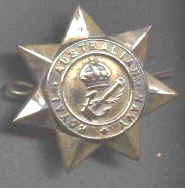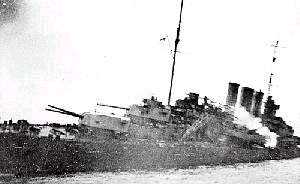 |
|
|||
|
|
||||
On 7th August, 1945, the U.S. 1st Marine Division landed on the islands of Guadalcanal and Tulagi and either killed or drove the Japanese garrisons there into the jungle. Some six hundred miles northwest, at the major Japanese base of Rabaul, Vice Admiral Gunichi Mikawa, the newly installed commander of the Eighth Fleet, immediately pulled together every warship at his disposal and headed south.
The last moments of HMAS Canberra.
He arrived off of the southern shore of Savo Island in the small hours of the morning of August 9th. Ahead of him were several groups of Allied warships, their crews exhausted from days of continuous combat operations. Due to the three entrances to the soon-to-be-infamous Ironbottom Sound, the Allied forces were compelled to divide their strength into three patrolling squadrons: Southern, Northern, and Eastern. The Allied vessels were not alert, and their commanders were in some cases either asleep or away from the actual scene of the action. Beyond the Allied warships lay a transport anchorage off of Lunga Point whose merchant vessels were still packed with equipment for the Marines ashore. The stage was set for the most humiliating defeat ever inflicted upon the US Navy. Mikawa's ships slipped unseen past the destroyer pickets at the mouth of the Sound, and soon came upon the southern group of Allied warships; two heavy cruisers (HMAS Canberra and USS Chicago) and two US destroyers. True to standard Japanese tactics, Mikawa's force first launched torpedoes and then followed up with devastating salvos of 8- and 6-inch gunfire. Canberra was in a sinking condition almost before she was aware that a battle had been joined. Chicago fared slightly better (she wasn't sunk), but never properly got into action, and (even worse) never alerted the Northern Force as to the presence of Mikawa's squadron. Fifteen minutes later, curving northward around Savo Island's eastern shore, the Japanese came upon the Northern Force, still steaming sedately along in a box patrol pattern. Mikawa's forces had become divided in the earlier exchange, and by chance enveloped the Allied Northern force from both sides. Taken unawares, and caught in a devastating crossfire, Northern Force's three heavy cruisers, Vincennes, Quincy, and Astoria, were quickly gunned into sinking hulks. At this point, having slaughtered the Allied escorts, the transport anchorage behind him lay open for Mikawa's taking. But the Japanese admiral's position was not as rosy as he would have wished. He had no idea that the US carriers (under Admiral Fletcher) covering the invasion had been withdrawn from the general vicinity. Attacking the transport anchorage would require his slowing, reassembling his scattered squadron, coming about, finding the anchorage, and then attacking it. It was now close to 2:00 AM. An attack on the anchorage, according to one of Mikawa's staff officers, would have added nearly two hours to the operation, placing Mikawa's force in a dangerous position when dawn broke at around 0400. Further, Mikawa had no idea as to what Allied vessels still remained unfought in the Sound. Consequently, shortly after 2:00 AM, he ordered a general retirement up The Slot. Ironically, having survived the fray around Savo, Kako fell victim to three torpedoes from the American submarine S-44 as a portion of the Japanese force approached the safety of Kavieng the next day. Thus ended the first instalment in a series of grim night battles around Guadalcanal. It was a spectacular tactical victory for the Japanese, but it was also shorn of the strategic advantage it might have achieved. |


